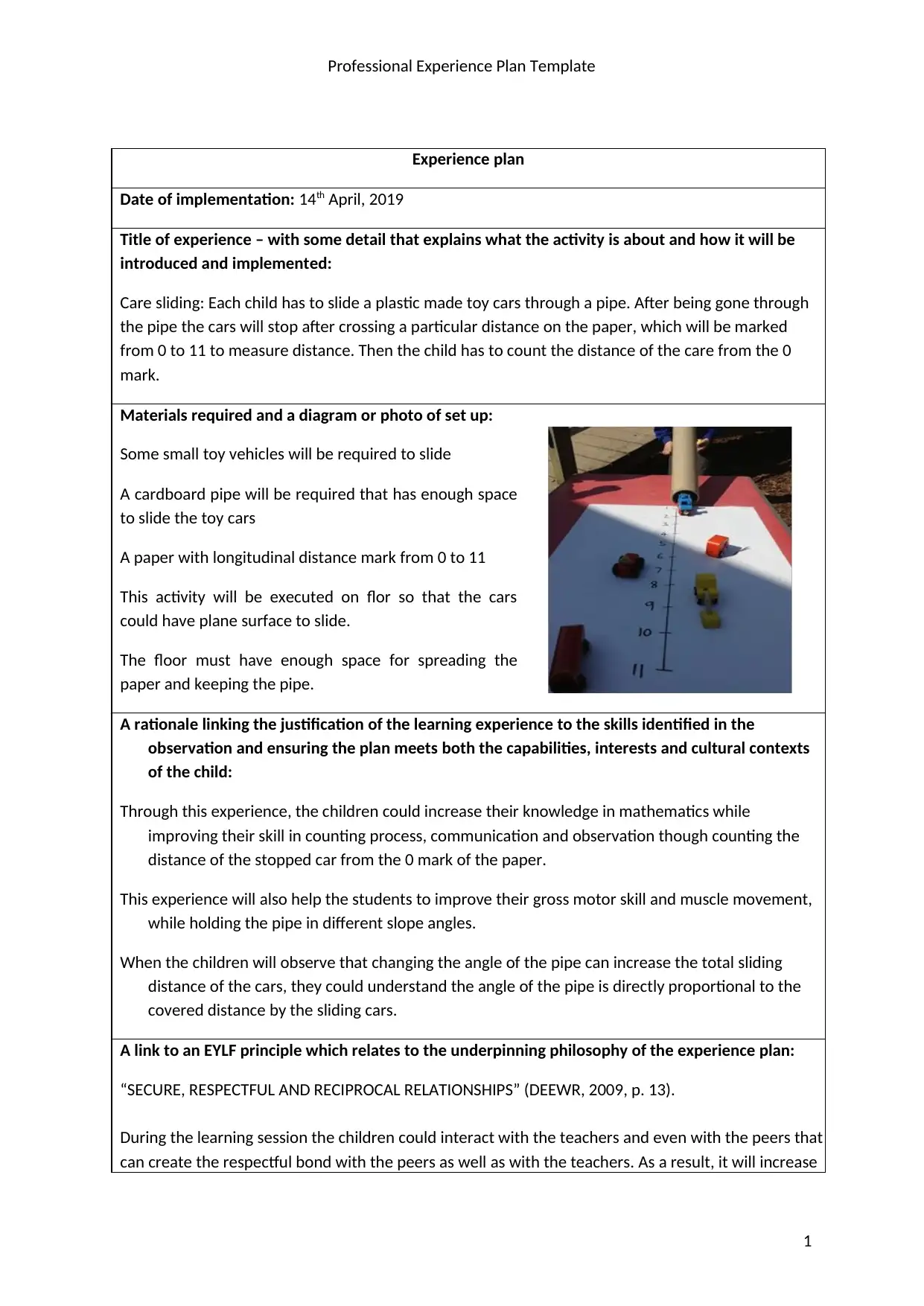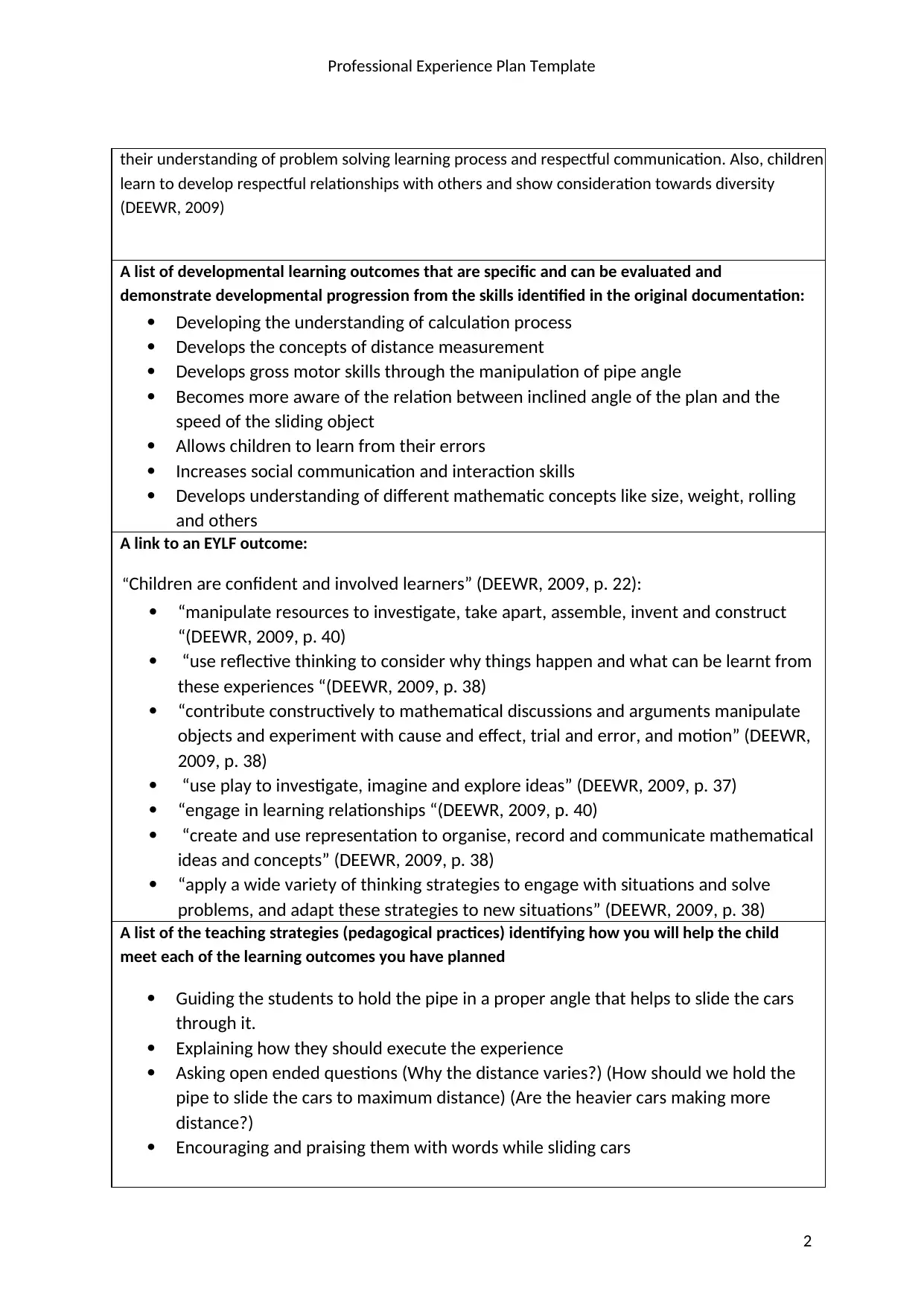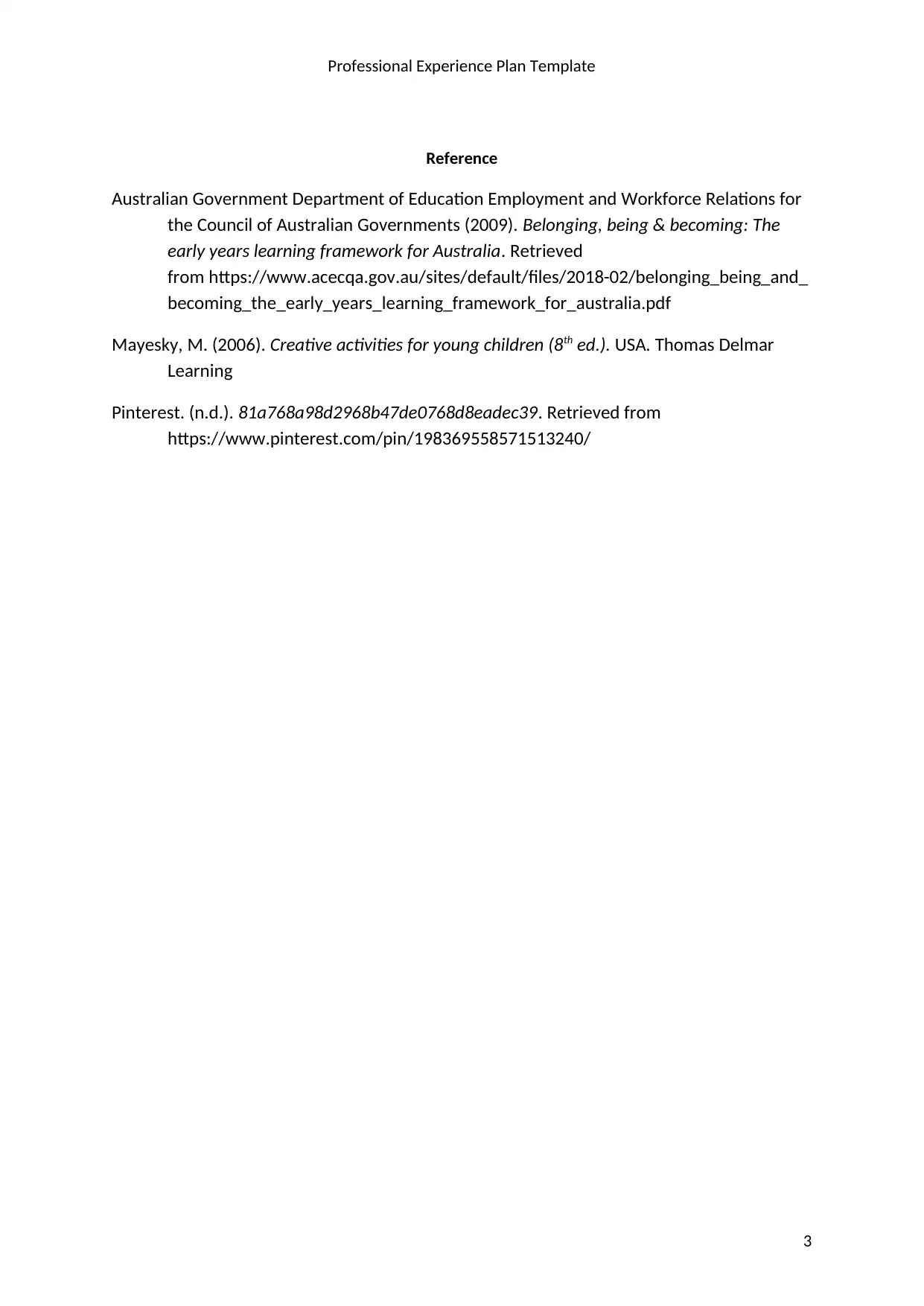Care Sliding Experience Plan for Early Childhood Education Program
VerifiedAdded on 2023/01/19
|3
|913
|72
Practical Assignment
AI Summary
This professional experience plan outlines a care sliding activity designed for early childhood education. The activity involves children sliding toy cars through a pipe and measuring the distance traveled. The plan includes a detailed description of the activity, required materials, and a rationale that links the experience to developmental skills, such as counting, communication, gross motor skills, and understanding mathematical concepts. The plan connects the activity to the EYLF principle of secure, respectful, and reciprocal relationships and provides specific developmental learning outcomes that can be evaluated. Teaching strategies include guiding children, asking open-ended questions, and encouraging their participation. The document also includes references to relevant literature and resources such as the EYLF framework and other educational materials.

Professional Experience Plan Template
Experience plan
Date of implementation: 14th April, 2019
Title of experience – with some detail that explains what the activity is about and how it will be
introduced and implemented:
Care sliding: Each child has to slide a plastic made toy cars through a pipe. After being gone through
the pipe the cars will stop after crossing a particular distance on the paper, which will be marked
from 0 to 11 to measure distance. Then the child has to count the distance of the care from the 0
mark.
Materials required and a diagram or photo of set up:
Some small toy vehicles will be required to slide
A cardboard pipe will be required that has enough space
to slide the toy cars
A paper with longitudinal distance mark from 0 to 11
This activity will be executed on flor so that the cars
could have plane surface to slide.
The floor must have enough space for spreading the
paper and keeping the pipe.
A rationale linking the justification of the learning experience to the skills identified in the
observation and ensuring the plan meets both the capabilities, interests and cultural contexts
of the child:
Through this experience, the children could increase their knowledge in mathematics while
improving their skill in counting process, communication and observation though counting the
distance of the stopped car from the 0 mark of the paper.
This experience will also help the students to improve their gross motor skill and muscle movement,
while holding the pipe in different slope angles.
When the children will observe that changing the angle of the pipe can increase the total sliding
distance of the cars, they could understand the angle of the pipe is directly proportional to the
covered distance by the sliding cars.
A link to an EYLF principle which relates to the underpinning philosophy of the experience plan:
“SECURE, RESPECTFUL AND RECIPROCAL RELATIONSHIPS” (DEEWR, 2009, p. 13).
During the learning session the children could interact with the teachers and even with the peers that
can create the respectful bond with the peers as well as with the teachers. As a result, it will increase
1
Experience plan
Date of implementation: 14th April, 2019
Title of experience – with some detail that explains what the activity is about and how it will be
introduced and implemented:
Care sliding: Each child has to slide a plastic made toy cars through a pipe. After being gone through
the pipe the cars will stop after crossing a particular distance on the paper, which will be marked
from 0 to 11 to measure distance. Then the child has to count the distance of the care from the 0
mark.
Materials required and a diagram or photo of set up:
Some small toy vehicles will be required to slide
A cardboard pipe will be required that has enough space
to slide the toy cars
A paper with longitudinal distance mark from 0 to 11
This activity will be executed on flor so that the cars
could have plane surface to slide.
The floor must have enough space for spreading the
paper and keeping the pipe.
A rationale linking the justification of the learning experience to the skills identified in the
observation and ensuring the plan meets both the capabilities, interests and cultural contexts
of the child:
Through this experience, the children could increase their knowledge in mathematics while
improving their skill in counting process, communication and observation though counting the
distance of the stopped car from the 0 mark of the paper.
This experience will also help the students to improve their gross motor skill and muscle movement,
while holding the pipe in different slope angles.
When the children will observe that changing the angle of the pipe can increase the total sliding
distance of the cars, they could understand the angle of the pipe is directly proportional to the
covered distance by the sliding cars.
A link to an EYLF principle which relates to the underpinning philosophy of the experience plan:
“SECURE, RESPECTFUL AND RECIPROCAL RELATIONSHIPS” (DEEWR, 2009, p. 13).
During the learning session the children could interact with the teachers and even with the peers that
can create the respectful bond with the peers as well as with the teachers. As a result, it will increase
1
Paraphrase This Document
Need a fresh take? Get an instant paraphrase of this document with our AI Paraphraser

Professional Experience Plan Template
their understanding of problem solving learning process and respectful communication. Also, children
learn to develop respectful relationships with others and show consideration towards diversity
(DEEWR, 2009)
A list of developmental learning outcomes that are specific and can be evaluated and
demonstrate developmental progression from the skills identified in the original documentation:
Developing the understanding of calculation process
Develops the concepts of distance measurement
Develops gross motor skills through the manipulation of pipe angle
Becomes more aware of the relation between inclined angle of the plan and the
speed of the sliding object
Allows children to learn from their errors
Increases social communication and interaction skills
Develops understanding of different mathematic concepts like size, weight, rolling
and others
A link to an EYLF outcome:
“Children are confident and involved learners” (DEEWR, 2009, p. 22):
“manipulate resources to investigate, take apart, assemble, invent and construct
“(DEEWR, 2009, p. 40)
“use reflective thinking to consider why things happen and what can be learnt from
these experiences “(DEEWR, 2009, p. 38)
“contribute constructively to mathematical discussions and arguments manipulate
objects and experiment with cause and effect, trial and error, and motion” (DEEWR,
2009, p. 38)
“use play to investigate, imagine and explore ideas” (DEEWR, 2009, p. 37)
“engage in learning relationships “(DEEWR, 2009, p. 40)
“create and use representation to organise, record and communicate mathematical
ideas and concepts” (DEEWR, 2009, p. 38)
“apply a wide variety of thinking strategies to engage with situations and solve
problems, and adapt these strategies to new situations” (DEEWR, 2009, p. 38)
A list of the teaching strategies (pedagogical practices) identifying how you will help the child
meet each of the learning outcomes you have planned
Guiding the students to hold the pipe in a proper angle that helps to slide the cars
through it.
Explaining how they should execute the experience
Asking open ended questions (Why the distance varies?) (How should we hold the
pipe to slide the cars to maximum distance) (Are the heavier cars making more
distance?)
Encouraging and praising them with words while sliding cars
2
their understanding of problem solving learning process and respectful communication. Also, children
learn to develop respectful relationships with others and show consideration towards diversity
(DEEWR, 2009)
A list of developmental learning outcomes that are specific and can be evaluated and
demonstrate developmental progression from the skills identified in the original documentation:
Developing the understanding of calculation process
Develops the concepts of distance measurement
Develops gross motor skills through the manipulation of pipe angle
Becomes more aware of the relation between inclined angle of the plan and the
speed of the sliding object
Allows children to learn from their errors
Increases social communication and interaction skills
Develops understanding of different mathematic concepts like size, weight, rolling
and others
A link to an EYLF outcome:
“Children are confident and involved learners” (DEEWR, 2009, p. 22):
“manipulate resources to investigate, take apart, assemble, invent and construct
“(DEEWR, 2009, p. 40)
“use reflective thinking to consider why things happen and what can be learnt from
these experiences “(DEEWR, 2009, p. 38)
“contribute constructively to mathematical discussions and arguments manipulate
objects and experiment with cause and effect, trial and error, and motion” (DEEWR,
2009, p. 38)
“use play to investigate, imagine and explore ideas” (DEEWR, 2009, p. 37)
“engage in learning relationships “(DEEWR, 2009, p. 40)
“create and use representation to organise, record and communicate mathematical
ideas and concepts” (DEEWR, 2009, p. 38)
“apply a wide variety of thinking strategies to engage with situations and solve
problems, and adapt these strategies to new situations” (DEEWR, 2009, p. 38)
A list of the teaching strategies (pedagogical practices) identifying how you will help the child
meet each of the learning outcomes you have planned
Guiding the students to hold the pipe in a proper angle that helps to slide the cars
through it.
Explaining how they should execute the experience
Asking open ended questions (Why the distance varies?) (How should we hold the
pipe to slide the cars to maximum distance) (Are the heavier cars making more
distance?)
Encouraging and praising them with words while sliding cars
2

Professional Experience Plan Template
Reference
Australian Government Department of Education Employment and Workforce Relations for
the Council of Australian Governments (2009). Belonging, being & becoming: The
early years learning framework for Australia. Retrieved
from https://www.acecqa.gov.au/sites/default/files/2018-02/belonging_being_and_
becoming_the_early_years_learning_framework_for_australia.pdf
Mayesky, M. (2006). Creative activities for young children (8th ed.). USA. Thomas Delmar
Learning
Pinterest. (n.d.). 81a768a98d2968b47de0768d8eadec39. Retrieved from
https://www.pinterest.com/pin/198369558571513240/
3
Reference
Australian Government Department of Education Employment and Workforce Relations for
the Council of Australian Governments (2009). Belonging, being & becoming: The
early years learning framework for Australia. Retrieved
from https://www.acecqa.gov.au/sites/default/files/2018-02/belonging_being_and_
becoming_the_early_years_learning_framework_for_australia.pdf
Mayesky, M. (2006). Creative activities for young children (8th ed.). USA. Thomas Delmar
Learning
Pinterest. (n.d.). 81a768a98d2968b47de0768d8eadec39. Retrieved from
https://www.pinterest.com/pin/198369558571513240/
3
⊘ This is a preview!⊘
Do you want full access?
Subscribe today to unlock all pages.

Trusted by 1+ million students worldwide
1 out of 3
Related Documents
Your All-in-One AI-Powered Toolkit for Academic Success.
+13062052269
info@desklib.com
Available 24*7 on WhatsApp / Email
![[object Object]](/_next/static/media/star-bottom.7253800d.svg)
Unlock your academic potential
Copyright © 2020–2025 A2Z Services. All Rights Reserved. Developed and managed by ZUCOL.




